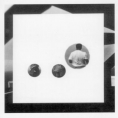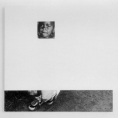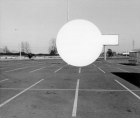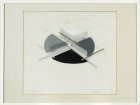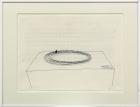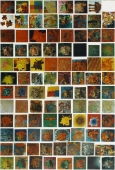
Artist | José Ferrero Villares (*1959)
https://www.artist-info.com/artist/Jose-Ferrero-Villares
Biography
Biography
* 1959 in Leon, Spanien
Graduado en Artes Plásticas, especialidad de Grabado y Ténicas de estampación.
Profesor de Fotografia y Ténicas de Reproducción.
About the work (english)
About the work (english)
in focus Galerie am Dom, Köln, zeigt vom 27. Oktober bis zum 19. November 2000 José Ferrero Villares und Karl Weibl
José Ferrero Villares - poetics of absence
We currently exist within a period of permanent reprinting of the languages of art, and of the extension of their apparent limits, and photography also makes its own bid to recover these possibilities, beyond its traditional dependence on other arts and on the undeniable services that it has rendered to them, and, through this, obtain the possibility of using concepts and languages, in their own forms of expression, contributed by the art of our time, authentic naturalisation papers as an artistic discipline. In this context, José Ferrero, an anxious artist like no other, has made a name for himself in the last stage of his photographic work, which has already afforded him well-deserved international recognition, due to his notable creative freedom within assumptions undoubtedly influenced by conceptual tendencies. José Ferrero, like any true artist in any discipline, strives to transfigure reality, to create, for the spectator, a reality different from everyday reality by way of photography. In his current work he raises what we could call a "register of absences", a series of works in which the image is only partially presented to us, creating new hope for the gaze and pronounced tension between the fragment and the whole, underlined by the sensation that what is not there is what really matters. It goes without saying that the success of the experience follows the wisdom of the artist in two decisions that he has taken: the election of the motif and the setting and, subsequently, of what has remained visible and of what has remained concealed. The empty spaces are activated by the remains of the images, which determines this dynamic of tension and the worrying and mysterious ambiguity of the photographs. The photographer leads us, on the other hand, to a type of estrangement, a sentimental complicity with the images: we feel as if they somehow concerned us. The tension become more intense as a result of this and because we tend to think that nothing seems definite in the scenes that we contemplate, nothing disappears irremediably, instead it is merely hidden, covered, pending contemplation of the scene at any time. Ferrero is like a magician, a conjurer who has made a part of the reality disappear, albeit temporarily, and he induces us to reconstruct it. A good example of this is the sequence from this page of a family album, a wedding that we feel strangely invited to, a theme particularly given to these poetics of absence in which José Ferrero works. His photographs promote the adventure of looking and oblige us to recompose or reinvent reality from those pieces of life that we lack.
Text by Rubén Suárez
Josö Ferrero Villares, richtet den Blick des Betrachters durch Gucklöcher oder Spalten auf einen oder mehrere Ausschnitte des Bildes. Er engt den Blick ein. So stellt er bestimmte Details heraus oder aber er deckt Fotografien soweit ab, dass rundum eine Art Rahmenbild entsteht. Die Fotografien werden um einen Keilrahmen gezogen. Der Betrachter kann sozusagen um die Ecke blicken. Die Schlüsselloch-Perspektive wirft den Neugierigen ein Stück weit auf sich zurück, auf seine selbstverständliche Vorerwartung, dass sich das Dargestellte leichthin entschlüsseln lasse. Villares entzieht uns den Gesamteindruck und deutet an, dass wir ohnehin immer nur einen Ausschnitt sehen, egal wo wir uns befinden und was wir sehen. Der Rahmen des Fotos suggeriert lediglich den Horizont des Abgelichteten. Selbst wenn wir meinen alles zu sehen, sehen wir doch nicht das Ganze.
Text von Anne Rosenbach, M.A. Kunstgeschichte
Solo Exhibitions (selection)
Solo Exhibitions (selection)
1987 Posada del Potro, Córdoba
1988 Ken Damy Gallery. Milan y Brescia, Italien)
1989 Galería Contraluz, Barcelona
1989 Museo Fundación Evaristo Valle. Gijón
1989 Galería Contraluz, Barcelona (Spanien)
1989 Museo Fundación Evaristo Valle, Gijón (Spanien)
1990 Centre National de la Photographie, Palais Tokio, Paris
1990 12 ième Festival Photográphique du Tregor, Francia
1990 Photoart Heidelberg, Alemania
1991 University of Wisconsin-Eau Claire, U.S.A.
1991 Museo de Bellas Artes de Asturias (Spanien)
1991 Galería del Colegio de Arquitectos, Córdoba (Spanien)
1992 Galería Vértice, Oviedo (Spanien)
1993 Galerie Periscope. Liège (Belgien)
1994 Abril Mes de la Fotografia X. Mérida, Mexico
1994 Mediatheque Louis Aragón, Tarbes (Frankreich)
1995 Museo de Bellas Artes de Santa Cruz de Tenerife (Spanien)
1996 Museo de Bellas Artes de Asturias, Oviedo
1996 Centro de Fotografia de Santa Cruz de Tenerife
1996 Museo de Bellas Artes de Asturias, Oviedo (Spanien)
1996 Galeria "Il Diaframma", Milano (Italien)
1996 Galerie Pierre Brullè, Paris
1996 Galerie "Collage", Quimper (Frankreich)
1996 Centro de Fotografía de Santa Cruz de Tenerife (Spanien)
1997 Galerie Nei Liicht, Dudelange (Luxemburg)
1998 Orangerie du Parc du Thabor, Rennes, Francia
1998 Le Grand Cordel, Rennes, Francia
1999 V Bienal FotoNoviembre, La Laguna, S.C. de Tenerife
1999 Galerie Pierre Brullè, Paris
1999 Galerie Pennings, Eindhoven (Holland)
2000 Archivo del Territorio Histórico de Álava, ATHA Vitoria-Gasteiz
2000 in focus Galerie am Dom, Köln (Deutschland)
Collections
Collections
EI Bibliotheque Nationale, Paris
Musée de la Photographie, Charleroi (Belgien)
Museo de Bellas Artes de Asturias (Spanien)
Ayuntamiento de Córdoba (Spanien)
Museo Antón Rodriguez, Candás (Spanien)
Museo Evaristo Valle, Gijón (Spanien)
Ayuntamiento de Sant Cugat, Barcelona (Spanien)
Fundación Noesis, Barcelona (Spanien)
Association Contact, Tarbes (Frankreich)
L'imagerie, Lannio. (Frankreich)
Cabildo de Tenerife. Sta. Cruz de Tenerife, (Spanien)
Hotel Dorint, Proyecto de integración de la fotografia en un espacio publico, Bruselas.
 offers / Requests offers / Requests  |
About this service |
|---|
 Exhibition Announcements Exhibition Announcements  |
About this service |
|---|
 Visualization |
Learn more about this service | ||
|---|---|---|---|

Interested in discovering more of this artist's networks?
3 easy steps: Register, buy a package for a visualization, select the artist.
See examples how visualization looks like for an artist, a curator, or an exhibition place: Gallery, museum, non-profit place, or collector.

Exhibition History

|
SUMMARY based on artist-info records. More details and Visualizing Art Networks on demand. Venue types: Gallery / Museum / Non-Profit / Collector |
||||||||||||
| Exhibitions in artist-info | 3 (S 1/ G 2) |
Did show together with - Top 5 of 7 artists (no. of shows) - all shows - Top 100
|
||||||||||
| Exhibitions by type | 3: 2 / 1 / 0 / 0 | |||||||||||
| Venues by type | 3: 2 / 1 / 0 / 0 | |||||||||||
| Curators | 0 | |||||||||||
| artist-info records | Jan 1999 - Aug 2001 | |||||||||||
|
Countries - Top 2 of 2 Spain (1) Netherlands (1) |
Cities 3 - Top of 3 Eindhoven (1) Köln (1) Gijón (1) |
Venues (no. of shows )
Top 3 of 3
|
||||||||||
|
Curators (no. of shows)
Top 0 of 0 |
| Museo Barjola | S | Jul 2001 - Aug 2001 | Gijón | (160) | +0 | |
| in focus galerie - Burkhard Arnold | G | Oct 2000 - Nov 2000 | Köln-Rodenkirchen | (134) | +0 | |
| Galerie Pennings | G | Jan 1999 - Dec 1999 | Eindhoven | (13) | +0 | |
| Keep reading |












